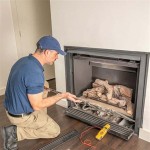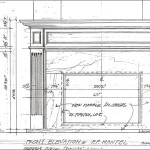How To Paint Over a Brick Fireplace
A brick fireplace often serves as a focal point in a living space, lending character and warmth to the room. However, its existing color or style may not always align with evolving aesthetic preferences. Painting a brick fireplace presents a viable option for updating its appearance to better complement the overall décor. While seemingly straightforward, the process requires careful planning and execution to ensure longevity and a professional finish. This article provides a comprehensive guide on how to paint a brick fireplace effectively, covering preparation, material selection, and application techniques.
Before embarking on the project, it is crucial to assess the condition of the brick and the surrounding area. Identifying and addressing any existing issues, such as efflorescence, soot buildup, or damaged mortar, is paramount to achieving a successful outcome. Proper preparation lays the foundation for a durable and visually appealing painted fireplace.
Preparing the Fireplace for Painting
The initial step in preparing a brick fireplace for painting involves thorough cleaning. Over time, brick surfaces accumulate dust, grime, soot, and potentially, efflorescence. These contaminants can interfere with paint adhesion, leading to premature peeling or an uneven finish. The cleaning process varies depending on the severity of the buildup.
Begin by dry-brushing the entire surface of the fireplace with a stiff-bristled brush, such as a scrub brush or a wire brush for heavily soiled areas. This removes loose debris, cobwebs, and surface dust. Following the dry brushing, vacuum the area to capture any remaining particles. Pay close attention to crevices and mortar joints, as these areas tend to harbor more dirt.
For general cleaning, a solution of warm water and mild detergent is usually sufficient. Apply the solution liberally to the brick surface using a sponge or cloth. Scrub gently to remove embedded dirt and grime. Rinse the area thoroughly with clean water to eliminate any soap residue. Allow the brick to dry completely before proceeding to the next step.
In cases of stubborn stains or soot buildup, a specialized brick cleaner may be necessary. These cleaners typically contain stronger solvents or acids designed to dissolve difficult deposits. Always follow the manufacturer's instructions carefully when using specialized cleaners. Wear appropriate protective gear, such as gloves and eye protection, to avoid skin or eye irritation. Ensure adequate ventilation in the work area to minimize exposure to fumes.
Efflorescence, a white, powdery deposit on the brick surface, is caused by salt deposits migrating to the surface. This can be removed by brushing with a wire brush and vacuuming. A diluted muriatic acid solution can also be used, but extreme caution is necessary. Always test the solution in an inconspicuous area first to ensure it does not damage the brick. Neutralize the acid with a baking soda solution after cleaning.
Once the cleaning is complete, inspect the mortar joints for any cracks or damage. Repair any deteriorated mortar with a suitable mortar patching compound. Allow the patching compound to cure completely before painting. This ensures a smooth and uniform surface for paint application.
Finally, protect the surrounding area from paint splatters by taping off the mantel, hearth, and walls with painter's tape. Cover the floor with drop cloths or protective sheeting to prevent paint spills from staining the flooring. Investing time in thorough preparation minimizes cleanup and ensures a professional-looking result.
Selecting the Right Paint and Primer
Choosing the appropriate paint and primer is crucial for the long-term durability and aesthetics of the painted brick fireplace. The porous nature of brick requires a primer that can effectively seal the surface, preventing excessive paint absorption and promoting adhesion. The paint itself should be durable, heat-resistant, and suitable for masonry surfaces.
A quality primer is essential for priming brick. Acrylic latex primers are generally recommended for interior brick surfaces. These primers offer excellent adhesion, flexibility, and resistance to alkali, which is naturally present in brick. Alkali can react with certain paints, causing them to deteriorate over time. Applying a primer specifically formulated to resist alkali helps to prevent this issue.
For fireplaces that are frequently used, consider using a high-heat primer. This type of primer is designed to withstand the high temperatures generated by the fire. It also helps to prevent the paint from blistering or peeling due to heat exposure. Apply the primer evenly in thin coats, allowing each coat to dry completely before applying the next. Follow the manufacturer's recommendations for drying times and application techniques.
The choice of paint depends on the desired aesthetic and the level of heat exposure the fireplace will experience. Latex paint is a popular choice for interior brick surfaces due to its ease of application, low odor, and durability. However, for fireplaces that are used frequently, a heat-resistant paint is recommended.
Heat-resistant paints are specially formulated to withstand high temperatures without blistering, cracking, or discoloring. These paints are typically available in limited colors and finishes, but they offer superior protection against heat damage. Choose a heat-resistant paint that is specifically designed for use on fireplaces or stoves.
Consider the desired finish when selecting the paint. Flat or matte finishes tend to conceal imperfections in the brick surface, while semi-gloss or gloss finishes offer greater durability and ease of cleaning. However, high-gloss finishes may accentuate imperfections. A satin finish is often a good compromise, providing a balance of durability and aesthetic appeal.
Before committing to a particular paint color, test it in an inconspicuous area of the fireplace. This allows you to assess how the color looks in the lighting conditions of the room and to ensure that it complements the existing décor. Purchase a small sample of the paint and apply it to a small section of the brick. Allow the paint to dry completely before evaluating the color. If necessary, adjust the color or finish to achieve the desired result.
Applying the Paint for a Professional Finish
The application of paint to a brick fireplace requires patience and attention to detail to achieve a professional and lasting finish. Using the right tools and techniques is essential for ensuring even coverage and preventing common problems such as drips, runs, and uneven texture.
Begin by applying the primer to the entire surface of the fireplace. Use a paintbrush to reach into the mortar joints and crevices, ensuring that all areas are thoroughly coated. A roller can be used for larger, flat surfaces to speed up the process. Apply the primer in thin, even coats, avoiding excessive buildup. Allow the primer to dry completely according to the manufacturer's instructions before proceeding to the next step.
Once the primer is dry, apply the first coat of paint. Use a paintbrush or roller, depending on the desired texture and the size of the surface. Work in small sections, overlapping each stroke slightly to ensure even coverage. Pay close attention to the mortar joints, making sure to fill them completely with paint. Avoid applying too much paint at once, as this can lead to drips and runs.
If using a paintbrush, use a technique called "stippling" to create a slightly textured finish. This involves dabbing the brush onto the brick surface rather than using long, sweeping strokes. Stippling helps to fill in the pores of the brick and creates a more natural-looking texture. A quality brush designed for rough surfaces ensures proper paint distribution in this method.
Allow the first coat of paint to dry completely before applying the second coat. This is important for ensuring proper adhesion and preventing the paint from peeling or blistering. Follow the manufacturer's recommendations for drying times. In humid or cool conditions, drying times may be extended.
After the first coat is dry, inspect the surface for any imperfections or areas that require additional coverage. Apply a second coat of paint, using the same techniques as before. This will help to improve the durability and longevity of the finish. Allow the second coat to dry completely before removing the painter's tape and drop cloths.
Once the paint is completely dry, carefully remove the painter's tape. Use a utility knife to score the edge of the tape before removing it, this helps to prevent the paint from peeling off with the tape. Inspect the finished fireplace for any touch-ups that may be needed. Use a small brush to apply touch-up paint to any areas that are missed or that have been damaged during the painting process.
Allow the fireplace to cure completely before lighting a fire. This allows the paint to fully harden and prevents it from being damaged by the heat. Follow the manufacturer's recommendations for curing times. Enjoy the updated look of the painted brick fireplace, which will enhance the aesthetic of the living space for years to come.

How To Paint A Brick Fireplace

How To Paint A Brick Fireplace What Use Home With Janny

How To Paint Your Fireplace Brick Surround

How To Update A Brick Fireplace With Chalk Paint Diy Beautify Creating Beauty At Home

How To Paint Your Brick Fireplace Katie Lamb

Painting Brick Fireplace White A Renovation Story

How To Paint A Brick Fireplace Beamin Moore
How To Update A Brick Fireplace With Chalk Paint Diy Beautify Creating Beauty At Home

Paint Your Brick Fireplace In 2 Easy Steps Birkley Lane Interiors

How To Paint A Brick Fireplace And Mantle
Related Posts








